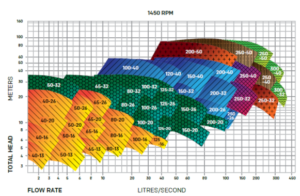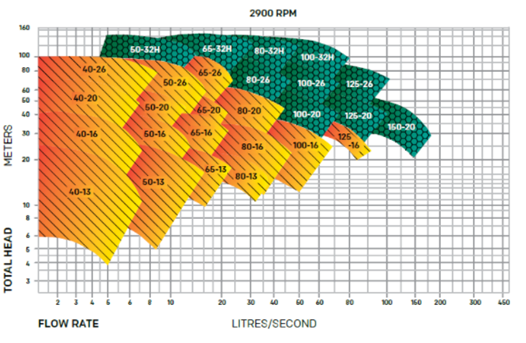Should my pumps be 4-pole or 2-pole?
The question often arises in HVAC pump selections- Should my pumps be driven at 4 pole (1450rpm nominal) or 2 pole (2900rpm nominal) speed?
Traditionally consulting engineers always specify 4 pole. This has and always will be good practice where the duty allows, but before deciding on this, one should consider several factors listed below:
The Operating Hours, Life Required and Downtime for Repairs
The main wearing parts on a pump set are mechanical seals, pump bearings and motor bearings.
The client usually expects a reasonable life with minimal maintenance i.e. a low Life Cycle Cost. To achieve this, one should consider operating hours and speed at the same time OR the total revolutions in the life of the pump. A pump which runs long hours is best selected at a lower speed than a pump which runs intermittently, to achieve a similar life.
The other factor is permissible downtime. If the pump does not have a standby unit, the system would be down while repairs/ replacements on bearings and seals were carried out. Hence it may be prudent to select a slower speed so that repairs need to be carried less frequently.
Acceptable Noise Levels
2 pole pumps are obviously noisier than 4 pole pumps, especially as the size increases (over 4kW). Hence 4 pole pumps should be used in noise sensitive areas.
The Application or System
For Condenser water systems where pumps are mounted adjacent to an open cooling tower, the typical NPSH available is minimal, mainly due to the tower being mounted at low level.
The NPSH available is also reduced by friction losses in suction strainers at towers and/ or at pumps as well as the tees, elbows, valves and reducers at the pump inlet. These losses can be reduced significantly by reducing velocity or increasing the pipe sizes. It is also important to follow the guidelines on velocity at the pump inlet as per the AIRAH Design Guide or Pump Handbook.
A 4 pole motor-driven pump usually has a lower NPSH required and hence it is easier to meet the requirement. For this reason, we highly recommend that 4 pole motor-driven pumps be used on these types of condenser water systems.
It is important to consider the above factors because it is an expensive and embarrassing exercise to make changes after the installation is complete.
The Performance and Efficiency
If the flow rate is small (under 4L/S) and the pressure is relatively high (greater than 150 kPa) it is most likely that a 2 pole motor-driven pump selection will offer superior performance and efficiency compared to 4 pole. This situation quite often applies to heating water applications where flows are low, pressure is reasonably high and they typically run for less time than cooling water pumps.
If 4 pole motor-driven pumps are considered for these low flow/ high pressure situations, the selection is often very inefficient, beyond the acceptable range of BEP and fraught with potential issues such as cavitation.
The selection curves below illustrate the comparison.


Conclusion
We appreciate and indeed share the engineer’s preference for 4 pole motor-driven pumps, especially for Cooling Tower applications.
However, when there are low flows/ high heads involved as is mostly the case on Heating Water systems, 2 pole selections offer the best result.
The online pump selection software is a great tool for making pump selections. It is web-based, free and easy to use. Simply click here to set up.
